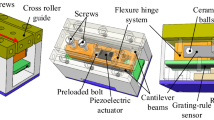Abstract
Nanopositioning stage, based on the stick–slip principle, is a hot research topic due to its unparallel merits such as compact structure, high resolution, and long travel stroke. However, most of the conventional stick–slip nanopositioning stages only have the ability to move along the horizontal directions. In addition, analysis of vertical stage movement is few. This paper proposes a novel stick–slip nanopositioning stage capable of moving upwards and downwards with an excellent performance. An adjusting unit was developed and integrated into the stage to effectively change friction force which is the key to the vertical stage movement. Theoretical and numerical analysis show that many parameters including revised driving signal contributes to the upward movement of stick–slip nanopositioning stage. Experimental results show that the stage has the capability of traveling up to 22 mm with an upward positioning accuracy of 7.00 nm and a downward positioning accuracy of 5.00 nm, respectively. The maximum speed for maximum speeds of stage for upward and downward motion were measured to be 2.70 and 0.77 mm/s, respectively. The maximum load of stage in vertical direction is 72 g. This stage design has a huge potential in applications requiring vertical manipulation while requiring nanometer positioning accuracies, high travel stroke, compact structure, and large load.


















Similar content being viewed by others
References
Assad O, Gilboa T, Spitzberg J, Juhasz M, Weinhold E, Meller A (2017) Light-enhancing plasmonic-nanopore biosensor for superior single-molecule detection. Adv Mater 29(9):1605442
Cheng G, Hu Y, Wen J, Zeng P, Xing C (2015) Piezoelectric inertial rotary actuators based on asymmetrically clamping structures. Sens Actuators, A 223:125–133
Cheng L, Liu W, Yang C, Huang T, Hou Z-G, Tan M (2017) A neural-network-based controller for piezoelectric-actuated stick-slip devices. IEEE Trans Ind Electron 65(3):2598–2607
De Wit CC, Olsson H, Astrom KJ, Lischinsky P (1995) A new model for control of systems with friction. IEEE Trans Autom Control 40(3):419–425
Feng J, Gao F, Zhao X, Yue Y, Liu R (2012) A new macro-micro dual drive parallel robot for chromosome dissection. J Mech Sci Technol 26(1):187–194
Gauthier Michaël, Piat Emmanuel (2006) Control of a particular micro-macro positioning system applied to cell micromanipulation. IEEE Trans Autom Sci Eng 3(3):264–271
Microsystems and micro/nano-technology in medical applications. Springer, Guadalajara, pp 236–245 (2002)
Howell LL (2001) Compliant mechanisms. Wiley, New York
Hunstig M, Hemsel T, Sextro W (2013) Stick-slip and slip–slip operation of piezoelectric inertia drives. Part I: ideal excitation. Sens Actuators A 200:90–100
King T, Xu W (1995) Piezomotors using flexure hinged displacement amplifiers. In: IEEE colloquium on innovative actuators for mechatronic systems, pp 232–237
Li Y, Xu Q (2010) A novel piezoactuated xy stage with parallel, decoupled, and stacked flexure structure for micro-/nanopositioning. IEEE Trans Ind Electron 58(8):3601–3615
Lobontiu N, Garcia E (2003) Analytical model of displacement amplifi-cation and stiffness optimization for a class of flexure-based compliant mechanisms. Comput Struct 81(32):2797–2810
Lu M, Gao S, Jin Q, Cui J, Du H, Gao H (2007) An atomic force microscope head designed for nanometrology. Meas Sci Technol 18(6):1735
Polit S, Dong J (2010) Development of a high-bandwidth xy nanopo-sitioning stage for high-rate micro-/nanomanufacturing. IEEE/ASME Trans Mechatron 16(4):724–733
Rakotondrabe M, Haddab Y, Lutz P (2009) Development, modeling, and control of a micro-/nanopositioning 2-dof stick–slip device. IEEE/ASME Trans Mechatron 14(6):733–745
Rong W, Zhang S, Yu M, Sun L (2011) A 3d stick-slip nanopositioner for nanomanipulation. In: 2011 IEEE international conference on mechatronics and automation. IEEE, pp 195–199
Rong W, Liang S, Wang L, Zhang S, Zhang W (2016) Model and control of a compact long-travel accurate-manipulation platform. IEEE/ASME Trans Mechatron 22(1):402–411
Shimizu Y, Peng Y, Kaneko J, Azuma T, Ito S, Gao W, Lu T-F (2013) Design and construction of the motion mechanism of an xy micro-stage for precision positioning. Sens Actuators A 201:395–406
Tian X, Zhang B, Liu Y, Chen S, Yu H (2019) A novel u-shaped step-ping linear piezoelectric actuator with two driving feet and low motion coupling: design, modeling and experiments. Mech Syst Signal Process 124:679–695
Xu D, Liu Y, Liu J, Yang X, Chen W (2017) Developments of a piezoelectric actuator with nano-positioning ability operated in bending modes. Ceram Int 43:S21–S26
Yong YK, Bhikkaji B, Moheimani SRR (2012) Design, modeling, and FPAA-based control of a high-speed atomic force microscope nanopositioner. IEEE/ASME Trans Mechatron 18(3):1060–1071
Zhang Y, Zhang W, Hesselbach J, Kerle H (2006) Development of a two-degree-of-freedom piezoelectric rotary-linear actuator with high driving force and unlimited linear movement. Rev Sci Instrum 77(3):035112
Zhang YL, Zhang Y, Ru C, Chen BK, Sun Y (2011) A load-lock-compatible nanomanipulation system for scanning electron microscope. IEEE/ASME Trans Mechatron 18(1):230–237
Zhao H-W, Wu B-D, Hua S-M, Yang Z-G, Cheng G-M, Qu X-T (2007) Dynamic performance of inchworm-type piezoelectric linear actuator. Opt Precis Eng 15(6):873–877
Zhong B, Wang Z, Chen L, Sun L (2011a) Current development of trans-scale precision positioning technology based on the stick-slip effect. Piezoelectr Acoustoopt 3:479–485
Zhong B, Wang Z, Chen L, Sun L (2011) Kinetic study of a novel trans-scale precision positioning stage based on stick-slip effect. In: Proceedings of 2011 international conference on electronic & mechanical engineering and information technology, vol 1. IEEE, pp 373–376
Zhong BW, Chen LG, Wang ZH, Sun LN (2011) Movement modeling and testing of a novel trans-scale precision positioning stage based on the stick-slip effect. In: Advanced materials research, vol 225. Trans Tech Publication, pp 684–687
Zhong B, Chen L, Wang Z, Sun L (2012) A novel trans-scale precision positioning stage based on the stick-slip effect. Int J Intell Mechatron Robot (IJIMR) 2(2):1–14
Funding
The funding was provided by National Natural Science Foundation of China (Grant No. 61774107) and Construction Project of Suzhou Late-model R&D institutions (Grant No. SZS2018337)
Author information
Authors and Affiliations
Corresponding author
Additional information
Publisher's Note
Springer Nature remains neutral with regard to jurisdictional claims in published maps and institutional affiliations.
Rights and permissions
About this article
Cite this article
Pan, P., Zhu, J., Gu, S. et al. Development of stick–slip nanopositioning stage capable of moving in vertical direction. Microsyst Technol 26, 2945–2954 (2020). https://doi.org/10.1007/s00542-020-04909-3
Received:
Accepted:
Published:
Issue Date:
DOI: https://doi.org/10.1007/s00542-020-04909-3



